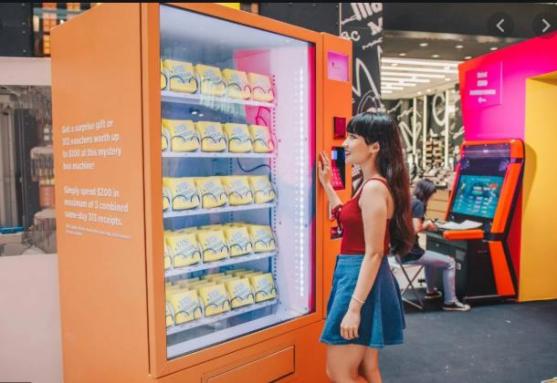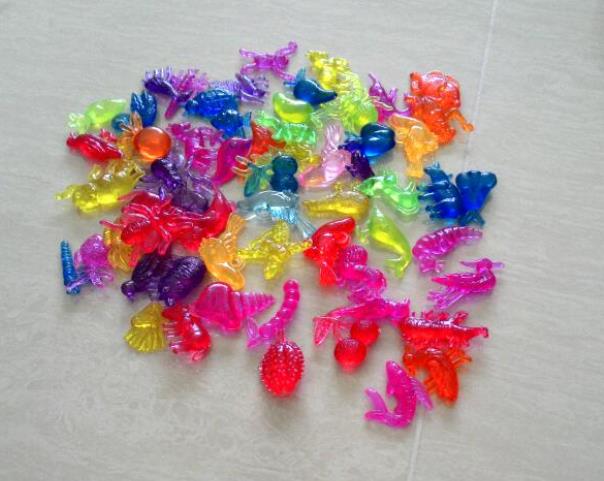So my son’s 10 years old and I’m not really sure where the seeds of his interest came from. The only time my wife and I talked about entrepreneurship in front of the kids was when he was in Primary 1. There was one Art lesson during the Chinese New Year period. Students had to use red packets to build a lantern. One of his classmates brought extra red packets and sold them to classmates who did not have enough. Lol, enterprising young lad!
Lucky draw game
When my son was in Primary 3, he came home one day and shared with me he was playing a “lucky draw” game with his friends. He made a bag which contained pieces of paper that were numbered. He would charge his friends 10 cents to pick a number for the chance to win a prize.
I was intrigued and asked him where he got the idea from. He reminded me when we were in Taipei the previous year on holiday, he saw vending machines with mystery boxes in them, much like the one in the picture below. In Taipei, each box promised the chance to get an iPhone. I remember he was extremely excited about wanting to play that vending machine. I did not expect him to model his “game” after those machines. I was amused but thought nothing more of it.

Kuti-Kuti
In Primary 4, he and his classmates started playing this traditional local game called “kuti kuti” where each player will control a small plastic animal. Each player is to maneuver his/her animal around the table with the aim of resting his/her animal over the other player’s animal. Once that is done, the game is won and the winner takes possession of the loser’s animal. This was very much like how I used to play the flag erasers with my friends when I was younger.

He started playing with large plastic animals. One weekend, he was out with his maternal grandfather when he saw a pack of the plastic animals selling for $2.50 for a pack of 10. He bought the pack, or his grandfather did anyway, and brought his new toys to school. He managed to sell each plastic animal for $1! In a few days, he sold all of them. Pretty good margin, lol.
He did not tell me any of this until it was over. When I found out about his transgressions away from school work, I did what any responsible parent would do. I laid down the law.
“Son, I need to tell you that your school work is the most important thing for you at this point.”
Pause.
“I’d also like you to think about growing this business.”
He stared at me blankly. I suggested we look online to see if he could purchase the plastic animals for cheaper. No self-respecting businessperson would buy from the first supplier he comes across. Lo and behold, we found a local supplier that was selling similar plastic animals, only they were smaller in size. The selling price was $15 for a pack of 1,200 animals. It felt like we had hit jackpot!
My son was concerned he could not sell the smaller animals for $1 like he did the bigger animals. And just like that, we started our first lesson on Business Accounting 101.
Business Accounting 101
Revenue – Costs = Profit. I explained that his cost was now $0.0125 per piece vs. $0.25 for the bigger animals. I showed him how he could re-price his animals to 10 cents per piece and still make good profit margin.
He decided to buy the pack. At checkout, we realized that we had to pay another $12 for shipping, almost doubling costs. Or we could drive to Woodlands to pick up the pack ourselves. He asked me if I could drive him there. I could have but I preferred not to take such a long drive. I took the opportunity to explain that every business has many costs, not just cost of goods sold. In this instance, shipping cost was a huge factor. We re-did our calculations and found that unit economics still made sense with shipping included.
I explained that if he wanted to sell the products, he would have to pay for the purchase from his own savings. Daddy was not going to fund his business like what Gong-Gong did the first round. (In fairness to him, most businesses start with some help from family and friends, so I would not be too hard on him there.) So I used my credit card to make the purchase and he handed me $27 from his savings.
A few days later, the shipment arrived. He was now in business.
A week later, I checked in with how he was doing. He was excited to share his news.
It turned out that his smaller animals were really popular. The larger animals at $1 a piece were quite expensive for many of his classmates but they found 10 cents for the smaller animals affordable. [Product-market fit? Check]
He had also discovered some of the plastic animals were built in such a way that made it easier for those pieces to win a game. For those pieces, he priced them higher. [Differential pricing? Check]
For classmates that were unwilling to buy the superior pieces, they ended up losing frequently to those who did. They would lose possession of their pieces and go back to him to buy more pieces. [Recurring revenue? Check]
In short, business was pretty good.
Partnership
A few days later, he shared with me another development. He had recruited a partner! The boy sitting next to him in class was now his partner. He would have his partner pass the plastic animals to the “buyers” sitting on his partner’s side of the classroom. My son would share revenue 50-50 with his partner.
It was now time for the second lesson in Partnerships.
I explained two things to him. First, partnerships are important. A good partner would be one that could complement his skills and/or bring additional value to his business. In this instance, my view was that his partner did not bring much to the table. His partner wasn’t even selling on his behalf, merely passing the purchased items over to the buyer. My son could have easily passed the items to the buyers during break time. An example of a good partner would be one who could sell the plastic animals to students from another class.
Second, by splitting revenue straight down the middle, his partner was in a more rewarding position than my son. My son was paying for the product and responsible for making the sale, all that for essentially less profit. His partner’s 5 cents was pure gravy with zero risk.
I advised him to come up with a different job scope and financial arrangement for his partner, which he did. He had his partner sell the plastic animals to students outside of his class and gave his partner a lower share of revenue. I think his partner was much less motivated after the change.
He also told me that he had shared with his partner info about where he purchased his inventory and how much it cost. I told him that this was fine as long as he trusted his partner. Even after explaining, I’m not sure he really understood that in a basic business like his, information asymmetry is important in maintaining competitive advantage.
Regulation
It was maybe about 3 or 4 weeks later that I realized he was no longer playing with his plastic animals at home. I asked him why. He told me sheepishly that his form teacher had stopped him from selling in class. Apparently, one parent was unhappy with his/her child spending money on my son’s plastic animals and complained to the form teacher.
While empathizing with my son, I couldn’t help but chuckle in my mind. I didn’t expect to talk about regulation so soon. I explained to him that in any business, rules and laws can affect business viability. I think this part flew right over his head.
A year later
Fast forward to Primary 5 and he’s now in a different class. He told me one day he wanted to try and sell his kuti kuti plastic animals again. I told him the best way to start was to first get his new classmates interested in playing the game. Only then could he generate interest in his “wares”. I don’t think he was keen on that path and was more interested in just selling.
A few days later, I checked in with him. He told me that he was only able to sell the plastic animals to one classmate.
A couple of weeks after that, he told me that the big fish was no longer buying from him. Someone else had told that boy he could buy a huge pack of those plastic animals for much cheaper. I reminded my son about our conversation a year earlier about proprietary business information. This was an example of how, when information asymmetry no longer existed, his competitive advantage eroded.
His most recent enterprise
During this lockdown period, he came up with the idea of massage vouchers. He gave his mum and I a stack of massage vouchers each. We could use those vouchers to redeem a massage session and pay him $1 for his efforts.
Only problem was, his younger sister (3 years younger) got in on the act and started offering her own massage vouchers, for 10cents a session, lol! Suffice to say, he was disappointed that his business was no longer viable. He got even more upset when my wife and I started utilizing his sister’s 10cent vouchers, lol.
In order to help him get over his disappointment, I explained to him how a massage business was essentially a commodity type business. In a commodity business where there is no product differentiation, participants can only compete based on price. Not a great business to be in. However, I asked him to think of ways to differentiate his business such that someone would choose his $1 massage over his sister’s 10cent massage. We came up with ideas such as a better massage experience, friendlier customer service, and other offerings.
Following that conversation, he asked me about other businesses. We talked about something he loved: MacDonald’s.
—————————————————————————————————————————————–
It’s been an interesting 2 years. Even though my skillsets lie in analyzing businesses rather than running them, I think it has been a short but rewarding journey for the both of us. No one knows where his entrepreneurial interests will bring him or if it will eventually peter out, but I’m certainly looking forward to guiding him on this journey!
Pingback: What We’re Reading (Week Ending 31 May 2020) - The Good Investors